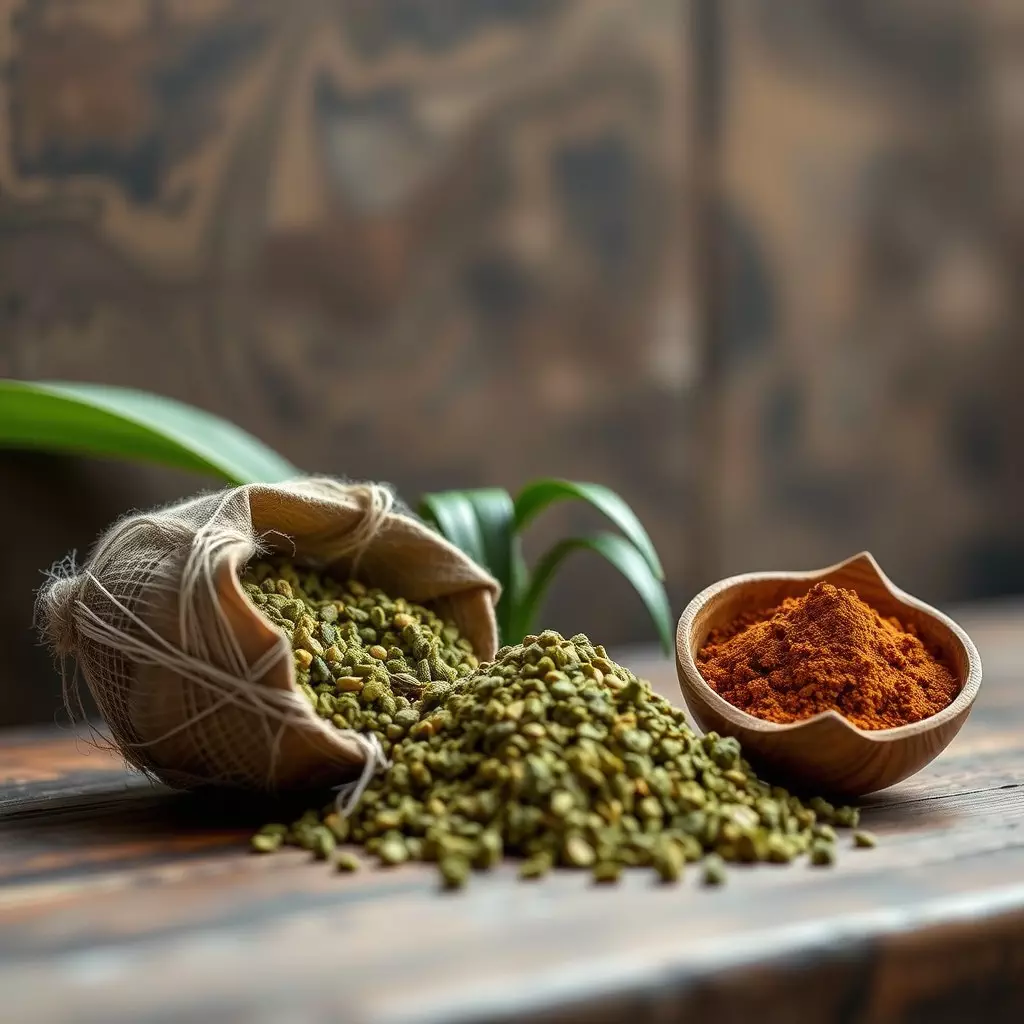Green Maeng Da and Red Bali are two distinct types of kratom, each offering unique benefits for natural pain management. Green Maeng Da is known for its balanced alkaloids that provide a blend of energy and pain relief, suitable for daytime use due to its stimulating effects without the sedation typically associated with opioids. Its alkaloid profile, featuring mitragynine and 7-hydroxymitragynine, interacts with opioid receptors to offer analgesic properties. Red Bali stands out for its strong analgesic and sedative effects, which are beneficial for evening pain relief and conditions that involve both pain and stress. Its high levels of 7-hydroxymitragynine make it a potent choice for those in need of significant pain management. When choosing between these two kratom strains, consider the time of day, the nature of your pain, and your personal preference to determine which one aligns best with your needs. Always consult with a healthcare provider before incorporating either Green Maeng Da or Red Bali into your health regimen, especially if you're managing chronic pain or taking other medications. Both strains can offer effective relief but should be used responsibly and in accordance with safe dosing practices to minimize potential side effects and risks of tolerance or dependence.
Exploring the realm of natural remedies, this article sheds light on kratom supplements as a potential avenue for pain management. Delving into the unique alkaloid compositions of Green Maeng Da and Red Bali strains, we compare their effects to offer insights into choosing the right kratom for your needs. User experiences and dosage considerations are also examined to guide individuals in utilizing these supplements effectively for pain relief. Join us as we navigate the complexities of green maeng da vs red bali within the context of natural pain management.
- Unveiling the Potential of Green Maeng Da and Red Bali Kratom for Natural Pain Management
- Comparing the Alkaloid Profiles and Effects: A Closer Look at Green Maeng Da and Red Bali
- User Experiences and Dosage Considerations in Managing Pain with Kratom Supplements
Unveiling the Potential of Green Maeng Da and Red Bali Kratom for Natural Pain Management

green Maeng Da and Red Bali kratom varieties have garnered significant attention in the realm of natural pain management due to their distinct alkaloid profiles and effects. Green Maeng Da, renowned for its balanced alkaloid content, is often favored for its energizing yet soothing properties, which can be beneficial for managing both acute and chronic pain conditions. The alkaloids present in Green Maeng Da, such as 7-hydroxymitragynine and mitragynine, are thought to interact with the body’s opioid receptors, providing analgesic effects that may help alleviate discomfort without the side effects commonly associated with synthetic pain medications.
On the other hand, Red Bali kratom is celebrated for its potent sedative and analgesic properties, making it a popular choice for individuals seeking relief from persistent or severe pain. The red vein variants are typically richer in certain alkaloids like 7-hydroxymitragynine, which contributes to their strong painkilling capabilities. Users often report that Red Bali kratom can offer profound relaxation alongside its analgesic benefits, which is particularly advantageous for those suffering from conditions that are not only painful but also stressful or debilitating. When comparing Green Maeng Da vs Red Bali, it’s clear that both have their unique roles in natural pain management strategies, with the choice between them often depending on an individual’s specific needs and preferences, as well as the nature of their pain.
Comparing the Alkaloid Profiles and Effects: A Closer Look at Green Maeng Da and Red Bali

When exploring the realm of natural pain management through kratom supplements, a critical aspect to consider is the comparison of alkaloid profiles and their respective effects between different strains. Among the most discussed are Green Maeng Da and Red Bali, each offering unique benefits that can influence a user’s experience with kratom.
Green Maeng Da, renowned for its energetic and uplifting properties, contains a balanced array of alkaloids, including Mitragynine and 7-Hydroxymitragynine, which are the primary active components in kratom. This blend is believed to provide pain relief while maintaining mental clarity and energy levels. Users often report that Green Maeng Da helps manage chronic pain without the sedating effects typically associated with opioid-based medications. Its stimulating nature also makes it a popular choice for those seeking motivation and focus during the day.
On the other hand, Red Bali is celebrated for its potent analgesic and sedative properties. The alkaloid profile in Red Bali is rich in 7-Hydroxymitragynine, which contributes to its painkilling effectiveness. This strain is often chosen by individuals seeking relief from acute or chronic pain with a more calming and relaxing experience. Its sedative effects can be particularly beneficial for pain management at night or for those experiencing stress and anxiety. The distinct profiles of these two strains highlight the importance of understanding alkaloid content when selecting kratom for personal use, as each can offer different therapeutic benefits based on the user’s needs and preferences.
User Experiences and Dosage Considerations in Managing Pain with Kratom Supplements

Users who turn to kratom supplements for natural pain management often report varying experiences based on strain selection, dosage, and individual physiology. Green Maeng Da, known for its invigorating and euphoric effects, is frequently cited by users for its potent analgesic properties. It is typically recommended to start with a lower dose to gauge individual sensitivity and gradually increase as needed, while always being mindful of the potential for tolerance and dependence. Conversely, Red Bali kratom is celebrated for its soothing and sedative qualities, which can be particularly effective for managing chronic pain or discomfort associated with stress. Users who prefer Red Bali often notice its effects more prominently when taken later in the day due to its relaxing nature. It is crucial to note that while many users find relief from pain using these strains, personal dosage considerations are paramount. Factors such as body weight, tolerance level, and the severity of pain should guide the amount used. Additionally, it’s recommended to adhere to guidelines for safe usage, which include not exceeding a certain threshold dose within a given timeframe to avoid adverse effects. As with any natural supplement, it is essential to consult with a healthcare provider before integrating kratom into one’s pain management regimen, especially if combining with other medications or for individuals with pre-existing health conditions.
Green Maeng Da and Red Bali kratom offer compelling alternatives for those seeking natural pain management solutions. The alkaloid profiles of these strains, while distinct, each present unique potential benefits. User experiences highlight the effectiveness of these supplements in managing various types of pain, with individual dosage considerations being paramount for optimizing their effects. As evidenced by the research and anecdotal evidence presented, a thoughtful approach to integrating Green Maeng Da vs Red Bali into one’s wellness regimen can be a valuable addition to holistic health practices. It is important to remember that individual responses may vary, and these supplements should be used responsibly as part of a comprehensive pain management plan under the guidance of a healthcare professional.






